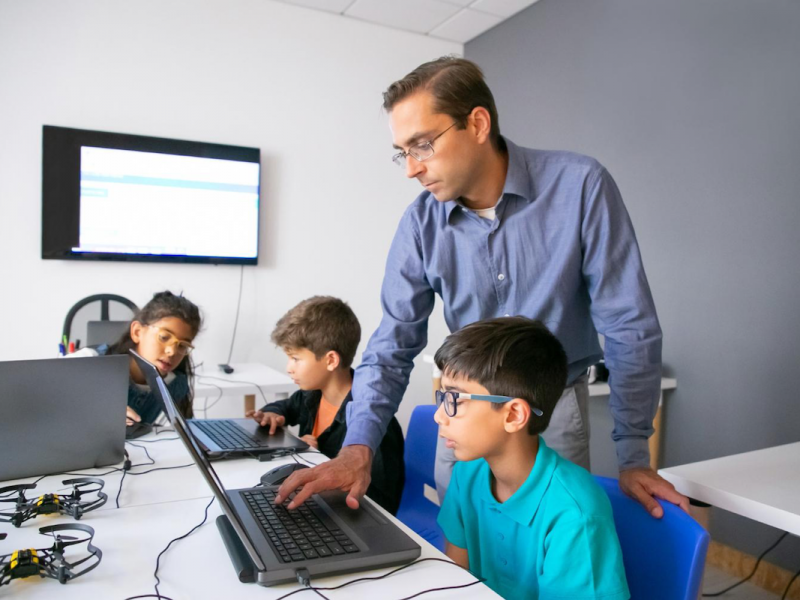“NEP 2020 is a holistic and progressive educational plan that will go a long way in building a robust India,” says Ashish Chaturvedi, founder of School Diary and uFony, in an interview with The Education Post Online
The digital divide is a real problem when it comes to online education,” says Ashish Chaturvedi, founder of School Diary. “However, the good news is that India has seen tremendous rise in smartphone adoption over last few years. Coupled with the fact that Indians enjoy the lowest data rates (Rs/GB) and access to good 4G networks, makes the digital divide a little less stark.”
In an interview with The Education Post Online, Ashish speaks on India’s new education policy, Covid-19, online education, and more. Here are the excerpts.
What’s your take on National Education Policy (in particular on School education)?
The New Education Policy, modified after a long hiatus of over 34 years, looks like a wholesome package to me! The two most striking aspects of the NEP 2020, for me however, are the redesigning of content to accommodate just the core essentials, thus encouraging understanding based learning, and the renewed focus on foundational literacy and numeracy among young children.
The Covid-19 pandemic created an existential crisis for k12 education as schools were suddenly forced to shut down in March 2020
Both of these, I feel, are vital in bringing about a paradigm shift in the quality of Indian education. Another key feature that the NEP 2020 has addressed, is the elimination of the decisive Board Exams and replacing it with a more structured variant of two examinations – the main and the improvement exam.
For years now, the dreaded Board examination has been a source of anxiety and fear among students and parents alike, as the future career prospects of a student depended on it. By replacing this with a more flexible option and introducing modular format of examination (Less content coverage per test), have together made the NEP 2020 a holistic and progressive educational policy that will go a long way in building a robust India.
The impact of Covid-19 on school education, and how technology is filling the gap?
The Covid-19 pandemic created an existential crisis for k12 education as schools were suddenly forced to shut down in March 2020. Everyone hoped that situation would return to normal in a few weeks and at most, sessions in April would be lost, which could be made up for through the year. However, as the pandemic spread, it became increasingly clear that physical classrooms would not be feasible for the foreseeable future, dealing a killer blow to the continuity of education.
On the flip side, children are spending a lot of time online. Be it for attending school classes, dance, music or art sessions, watching online movies, playing games or talking to their friends
Further, the disruption in education and the widespread economic slowdown led more blows to the revenue generation for schools, as more and more parents were feeling the impact of the slowdown. Parents became hesitant to pay full fees and demanded waivers and discounts, given that classes were not being conducted.
Going forward, the attention is likely to shift to online examinations as it is clear that physical classrooms may not be functional this year
The absence of traditional means of fee collection, like on premise cheque /cash collection, and ongoing expenses in the form of staff salaries, premise management and basic operational costs, with marginal savings on electricity & other sundry expenses, added to the cash crunch. Under such circumstances, technology adoption was the only answer to survive.
Overnight, virtual classrooms become a norm rather than an exception. Digital content creation and delivery took center stage. Parents and student engagement became critical. And online fee collection became a norm. Tools like Zoom, Google meet, and School Diary® Virtual Classroom gained prominence. Parent engagement apps delivering key communications & content/homework gained traction while online payments and reconciliation eventually enabled schools to collect fees online, a must for survival.
Going forward, the attention is likely to shift to online examinations as it is clear that physical classrooms may not be functional this year. So assessments and proctoring will take center stage. Here again technology will come to the rescue and help schools conduct smooth online exams.
On the flip side, children are spending a lot of time online. Be it for attending school classes, dance, music or art sessions, watching online movies, playing games or talking to their friends. Kids need ways to digitally detox. I feel here again the technology can come to rescue and offer avenues where parents can buy curated non academic books, STEM toys, self-assemble electronic kits etc. that the kids can spend their time on.
Do you think India’s digital divide is a cause for concern when online education is on the surge?
The digital divide is a real problem. However, the good news is that India has seen tremendous rise in smartphone adoption over last few years. Coupled with the fact that Indians enjoy the lowest data rates (Rs/GB) and access to good 4G networks, makes the digital divide a little less stark.
Different schools are using technology in different ways. In cities, where smartphones are rampant and bandwidth is good, we see teachers conducting online classes smoothly. In towns and rural areas, we see teachers recording short tutorials and/or curating good content from internet and sharing it with students over School Diary or other such platforms.
I am confident that this divide will reduce drastically going forward as our networks migrate to 5G, smartphones get cheaper and ubiquitous and more and more schools realize the edge that tech platforms bring to their operations.
Could you tell what inspired you to start School Diary and the impact of the platform on children?
Well, it’s serendipitous how I conceived School Diary. We had launched our first product in 2012, a contextual communication platform, and by 2014 it wasn’t scaling as we expected. During that time, one day I was dropping my elder son to the bus stop and I discovered that he had to carry a chart paper and few stationary items for a class activity that day. The teacher may have sent a note in his diary few days ago but we missed it and were unaware about it. I felt completely disconnected with what was happening at his school.
On the other hand, my wife was a teacher at that time and she was struggling to communicate with parents, as she didn’t want to share her number with everyone and there was no other easy way. It dawned upon me then, that our communication platform could actually be a very useful tool for the school.
I took the idea to my son’s school and offered them free usage to explore the benefits. They used it for a few months and loved it and eventually became our first paying customer. At that time it became clear that teacher-parent communication and engagement was a major problem begging to be solved. Back then, smartphones were not ubiquitous and we faced a lot of challenges to break the barriers to digital adoption.
But thanks to the smart-phone revolution that followed, we could crack several problems that schools faced and could scale our solution to 200,000+ parents across 10+ countries. I can proudly share that the adoption of our platform improves the overall parent and teacher engagement eventually leading to impressive performance improvement in children.
(This interview was first published in ”The Education Post” on Aug 19,2020)


